Abstract
Chromogranin A (CGA) is a ubiquitous 48-kDa secretory protein present in adrenal medulla, anterior pituitary, central and peripheral nervous system, endocrine gut, thyroid, parathyroid, and endocrine pancreas. Recently, we have demonstrated that the protein could be a precursor of bioactive peptides capable of modulating catecholamine secretion from cultured adrenal medullary chromaffin cells. Here we cleaved CGA purified from bovine chromaffin granules with endoproteinase Lys-C, and we isolated and partially sequenced the peptide inhibiting catecholamine secretion from cultured chromaffin cells. A corresponding synthetic peptide composed of the first 20 N-terminal amino acids produced a dose-dependent inhibition in the 10(-9) to 10(-6) M range (with an ID50 of 5 nM) of the catecholamine secretion evoked by carbamoylcholine or by potassium at a depolarizing concentration. This peptide affected secretagogue-induced calcium fluxes but did not alter sodium fluxes. It was found to increase desensitization of cell responses and to modify the kinetics of catecholamine release. Our results indicate that the peptide is extracellularly generated from CGA by a calcium-dependent proteolytic mechanism. We suggest that this peptide, named chromostatin, may be an endocrine modulator of catecholamine-associated responses.
Full text
PDF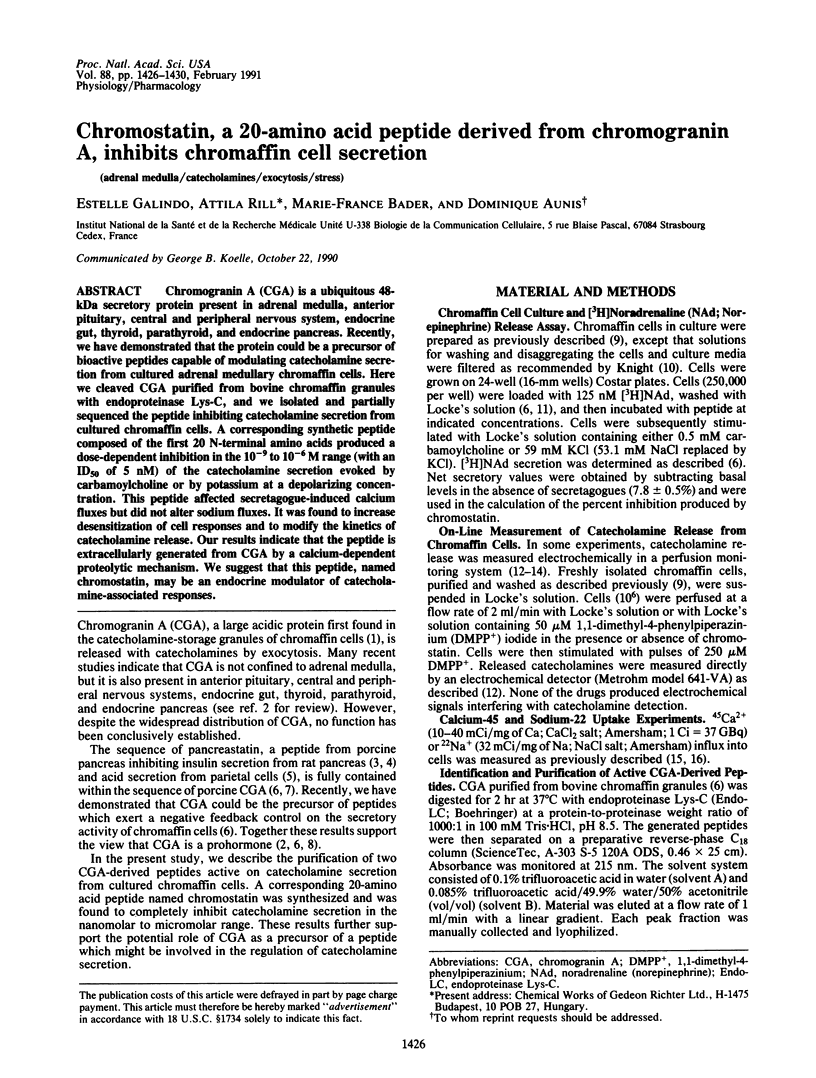
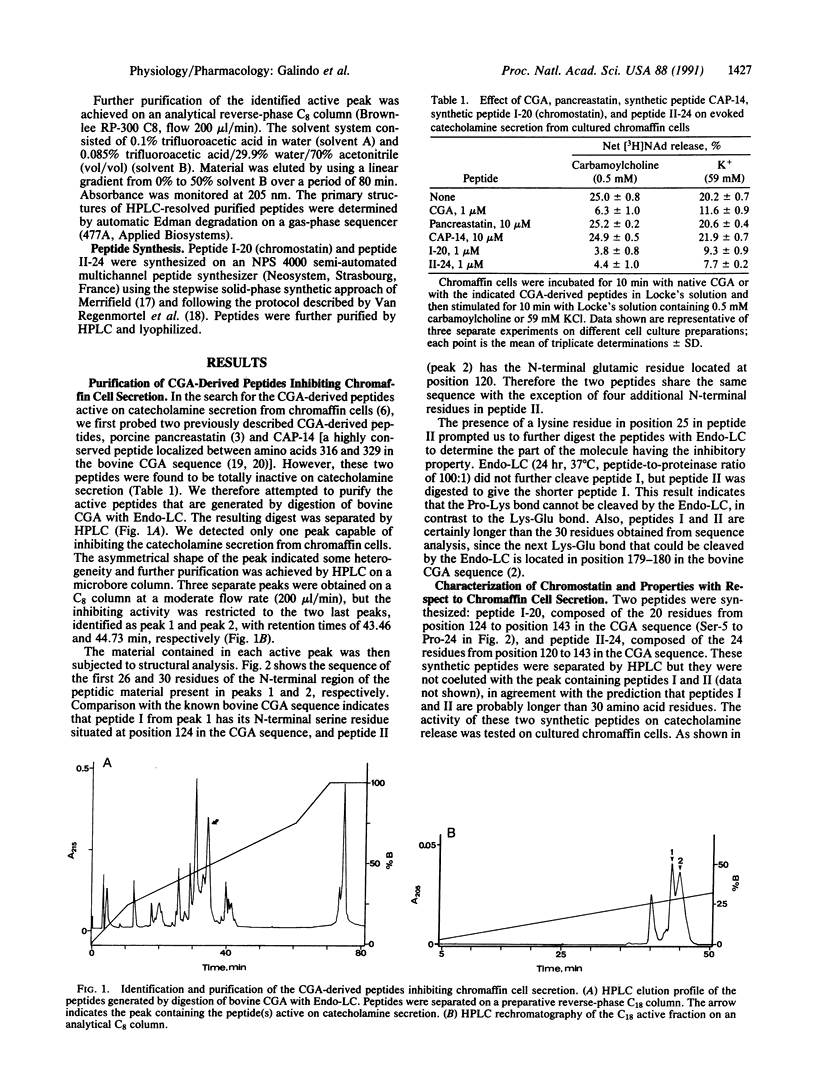
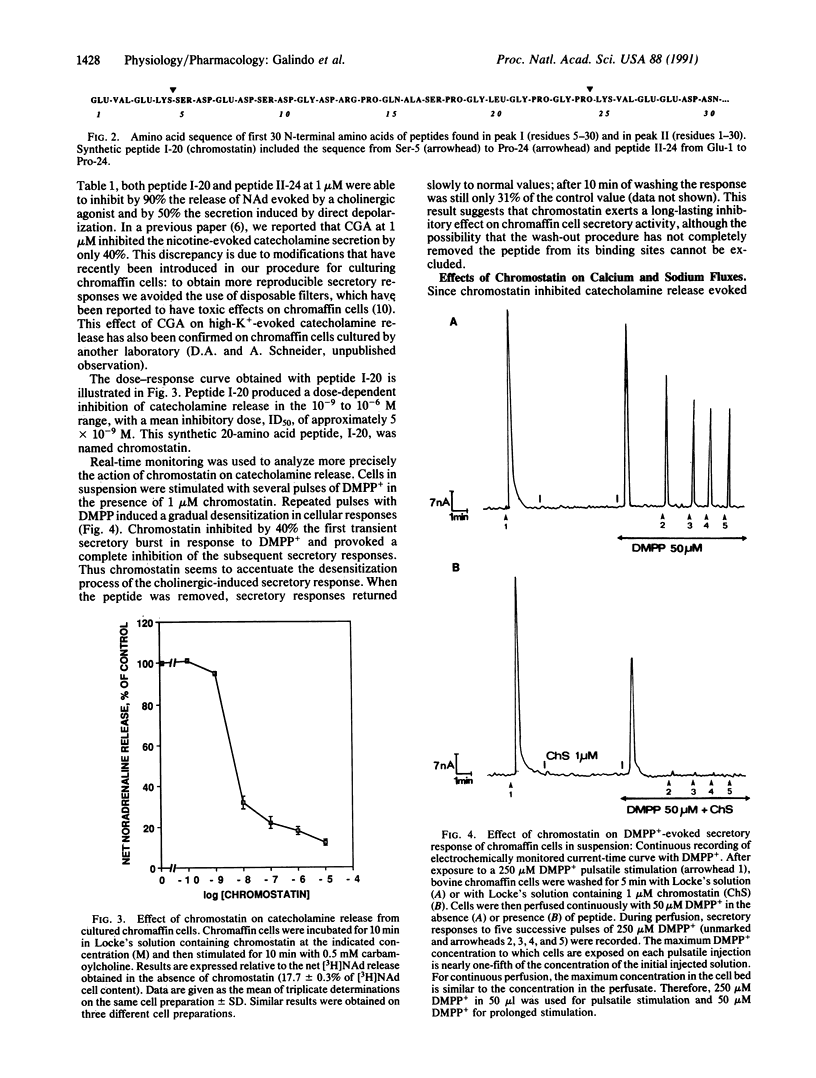
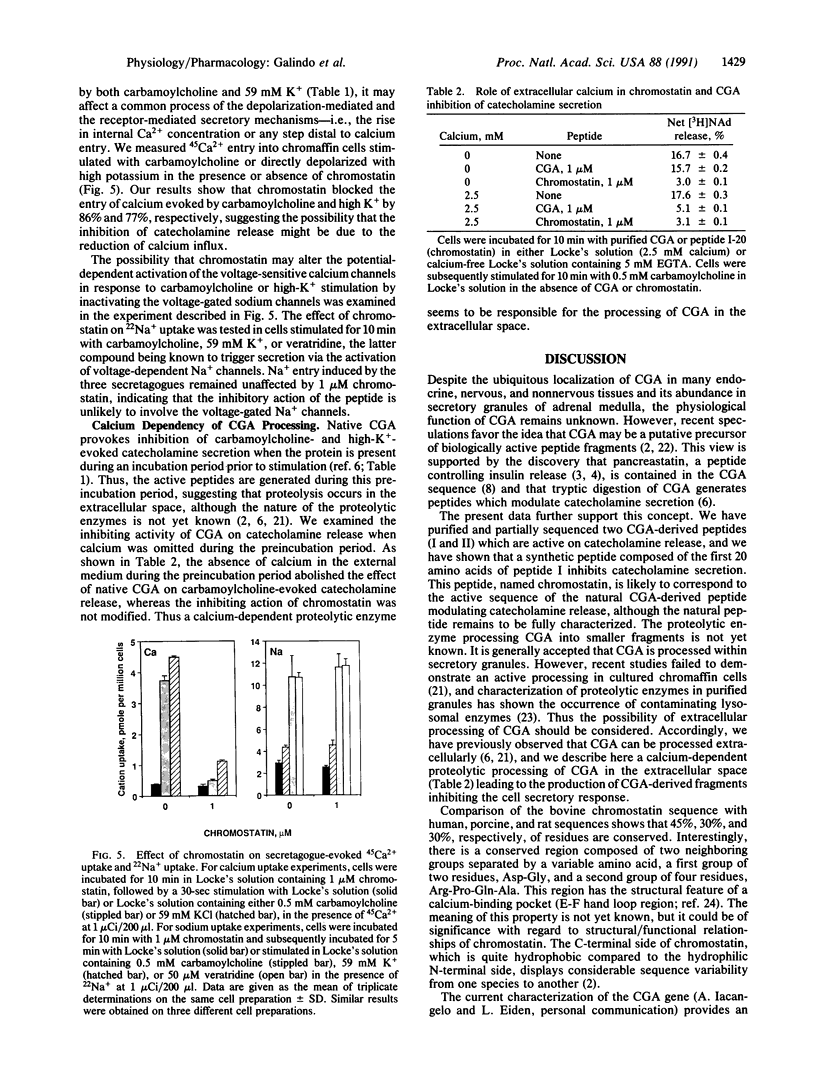
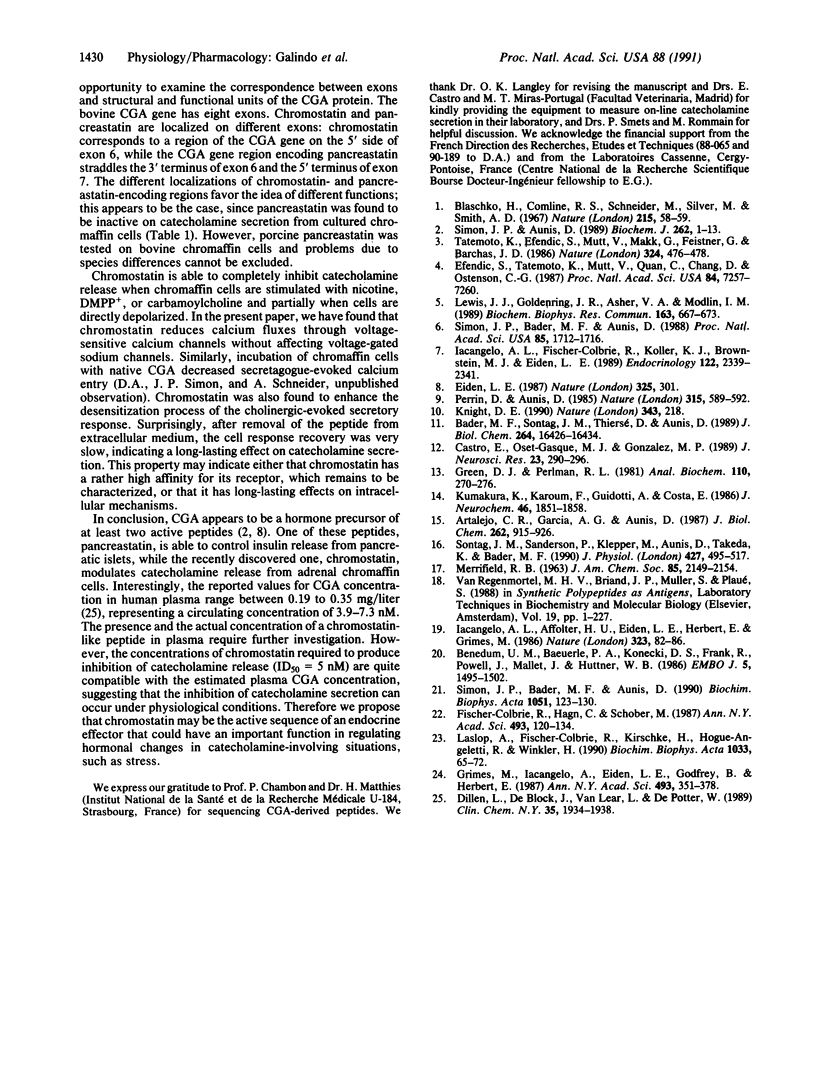
Images in this article
Selected References
These references are in PubMed. This may not be the complete list of references from this article.
- Artalejo C. R., García A. G., Aunis D. Chromaffin cell calcium channel kinetics measured isotopically through fast calcium, strontium, and barium fluxes. J Biol Chem. 1987 Jan 15;262(2):915–926. [PubMed] [Google Scholar]
- Bader M. F., Sontag J. M., Thiersé D., Aunis D. A reassessment of guanine nucleotide effects on catecholamine secretion from permeabilized adrenal chromaffin cells. J Biol Chem. 1989 Oct 5;264(28):16426–16434. [PubMed] [Google Scholar]
- Benedum U. M., Baeuerle P. A., Konecki D. S., Frank R., Powell J., Mallet J., Huttner W. B. The primary structure of bovine chromogranin A: a representative of a class of acidic secretory proteins common to a variety of peptidergic cells. EMBO J. 1986 Jul;5(7):1495–1502. doi: 10.1002/j.1460-2075.1986.tb04388.x. [DOI] [PMC free article] [PubMed] [Google Scholar]
- Blaschko H., Comline R. S., Schneider F. H., Silver M., Smith A. D. Secretion of a chromaffin granule protein, chromogranin, from the adrenal gland after splanchnic stimulation. Nature. 1967 Jul 1;215(5096):58–59. doi: 10.1038/215058a0. [DOI] [PubMed] [Google Scholar]
- Castro E., Oset-Gasque M. J., González M. P. GABAA and GABAB receptors are functionally active in the regulation of catecholamine secretion by bovine chromaffin cells. J Neurosci Res. 1989 Jul;23(3):290–296. doi: 10.1002/jnr.490230307. [DOI] [PubMed] [Google Scholar]
- Dillen L., De Block J., Van Lear L., De Potter W. Enzyme-linked immunosorbent assay for chromogranin A. Clin Chem. 1989 Sep;35(9):1934–1938. [PubMed] [Google Scholar]
- Efendić S., Tatemoto K., Mutt V., Quan C., Chang D., Ostenson C. G. Pancreastatin and islet hormone release. Proc Natl Acad Sci U S A. 1987 Oct;84(20):7257–7260. doi: 10.1073/pnas.84.20.7257. [DOI] [PMC free article] [PubMed] [Google Scholar]
- Eiden L. E. Is chromogranin a prohormone? Nature. 1987 Jan 22;325(6102):301–301. doi: 10.1038/325301a0. [DOI] [PubMed] [Google Scholar]
- Fischer-Colbrie R., Hagn C., Schober M. Chromogranins A, B, and C: widespread constituents of secretory vesicles. Ann N Y Acad Sci. 1987;493:120–134. doi: 10.1111/j.1749-6632.1987.tb27189.x. [DOI] [PubMed] [Google Scholar]
- Green D. J., Perlman R. L. On-line measurement of catecholamine secretion. Anal Biochem. 1981 Jan 15;110(2):270–276. doi: 10.1016/0003-2697(81)90191-3. [DOI] [PubMed] [Google Scholar]
- Grimes M., Iacangelo A., Eiden L. E., Godfrey B., Herbert E. Chromogranin A: the primary structure deduced from cDNA clones reveals the presence of pairs of basic amino acids. Ann N Y Acad Sci. 1987;493:351–378. doi: 10.1111/j.1749-6632.1987.tb27218.x. [DOI] [PubMed] [Google Scholar]
- Iacangelo A. L., Fischer-Colbrie R., Koller K. J., Brownstein M. J., Eiden L. E. The sequence of porcine chromogranin A messenger RNA demonstrates chromogranin A can serve as the precursor for the biologically active hormone, pancreastatin. Endocrinology. 1988 May;122(5):2339–2341. doi: 10.1210/endo-122-5-2339. [DOI] [PubMed] [Google Scholar]
- Iacangelo A., Affolter H. U., Eiden L. E., Herbert E., Grimes M. Bovine chromogranin A sequence and distribution of its messenger RNA in endocrine tissues. Nature. 1986 Sep 4;323(6083):82–86. doi: 10.1038/323082a0. [DOI] [PubMed] [Google Scholar]
- Knight D. E. Disposable filters may damage your cells. Nature. 1990 Jan 18;343(6255):218–218. doi: 10.1038/343218a0. [DOI] [PubMed] [Google Scholar]
- Kumakura K., Ohara M., Satô G. P. Real-time monitoring of the secretory function of cultured adrenal chromaffin cells. J Neurochem. 1986 Jun;46(6):1851–1858. doi: 10.1111/j.1471-4159.1986.tb08504.x. [DOI] [PubMed] [Google Scholar]
- Laslop A., Fischer-Colbrie R., Kirschke H., Hogue-Angeletti R., Winkler H. Chromogranin A-processing proteinases in purified chromaffin granules: contaminants or endogenous enzymes? Biochim Biophys Acta. 1990 Jan 29;1033(1):65–72. doi: 10.1016/0304-4165(90)90195-3. [DOI] [PubMed] [Google Scholar]
- Lewis J. J., Goldenring J. R., Asher V. A., Modlin I. M. Pancreastatin: a novel peptide inhibitor of parietal cell signal transduction. Biochem Biophys Res Commun. 1989 Sep 15;163(2):667–673. doi: 10.1016/0006-291x(89)92275-4. [DOI] [PubMed] [Google Scholar]
- Perrin D., Aunis D. Reorganization of alpha-fodrin induced by stimulation in secretory cells. Nature. 1985 Jun 13;315(6020):589–592. doi: 10.1038/315589a0. [DOI] [PubMed] [Google Scholar]
- Simon J. P., Aunis D. Biochemistry of the chromogranin A protein family. Biochem J. 1989 Aug 15;262(1):1–13. doi: 10.1042/bj2620001. [DOI] [PMC free article] [PubMed] [Google Scholar]
- Simon J. P., Bader M. F., Aunis D. Proteolytic processing of chromogranin A in cultured chromaffin cells. Biochim Biophys Acta. 1990 Feb 19;1051(2):123–130. doi: 10.1016/0167-4889(90)90183-e. [DOI] [PubMed] [Google Scholar]
- Simon J. P., Bader M. F., Aunis D. Secretion from chromaffin cells is controlled by chromogranin A-derived peptides. Proc Natl Acad Sci U S A. 1988 Mar;85(5):1712–1716. doi: 10.1073/pnas.85.5.1712. [DOI] [PMC free article] [PubMed] [Google Scholar]
- Sontag J. M., Sanderson P., Klepper M., Aunis D., Takeda K., Bader M. F. Modulation of secretion by dopamine involves decreases in calcium and nicotinic currents in bovine chromaffin cells. J Physiol. 1990 Aug;427:495–517. doi: 10.1113/jphysiol.1990.sp018184. [DOI] [PMC free article] [PubMed] [Google Scholar]
- Tatemoto K., Efendić S., Mutt V., Makk G., Feistner G. J., Barchas J. D. Pancreastatin, a novel pancreatic peptide that inhibits insulin secretion. Nature. 1986 Dec 4;324(6096):476–478. doi: 10.1038/324476a0. [DOI] [PubMed] [Google Scholar]



